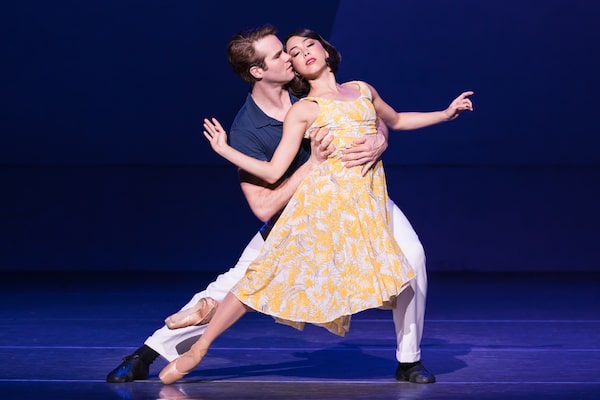
McGee Maddox and Allison Walsh in An American in Paris.Mirvish
- An American in Paris
- Directed and choreographed by Christopher Wheeldon
- At the Princess of Wales Theatre in Toronto through April 29
The finest part of Vincente Minnelli’s campy 1951 movie An American in Paris is the dancing – it culminates in an elaborate and unabashedly weird ballet that unfurls onscreen just as the narrative action is wrapping up. Imagine that ballet reconceptualized by one of world’s most esteemed classical choreographers, and you’ll get a sense of what Christopher Wheeldon’s stage adaptation of the movie, which opened at the Princess of Wales Theatre in Toronto on Thursday night, can do at its best.
Wheeldon’s production premiered in Paris in 2015 before winning four Tony Awards on Broadway and garnering fairly consistent critical acclaim. You have to speculate that the first-rate ballet dancers who stood in for Gene Kelly (Robert Fairchild) and Leslie Caron (Leanne Cope) were real triple-threats, able to sing beautifully while bringing passion and humanity to this postwar tale of American-boy-meets-French-girl love. The touring cast is also led by two accomplished classical dancers –former National Ballet of Canada principal McGee Maddox as Jerry Mulligan and former Joffrey Ballet soloist Allison Walsh as Lise Dassin. But their inconsistency with song and text takes us some distance from midtown Manhattan’s best.
Forties and fifties humour, with its oh-so-droll retorts and banal escapism, can get hokey quickly, and playwright Craig Lucas’ new script alternates between rectifying and exacerbating the problem. There’s an uninspired motif of words lost in translation, along with punchlines that fall flat, but there’s also greater emotional depth. The spectre of war and occupation hangs more heavily in this production – Nazi insignia flash across the cityscape, and an early tableau shows Parisians attacking a collaborator on the street.
Moreover, the character of Lise is vastly improved. In the film, the dancer-cum-shop girl is somewhat unbearable as a naive and pouty blank slate. Lucas has given the character more agency and backstory. She’s Jewish and longs to honour the memory of her parents’ love (who may or may not have been killed in the camps) and marry the American soldier-cum-aspiring painter who has won her heart. However, she grapples with her duty to the family who hid her throughout the war, and the consequent obligation to marry their son, the textile baron Henri Baurel (played and sung dynamically by tenor Ben Michael).
The tension between art, love and honour comes together more cohesively in Lucas’s version by having the whole story centre on the ballet. Jerry’s benefactress, the American Milo Davenport (played with stylish confidence by Kirsten Scott) isn’t an art patron, but a wealthy donor in the dance world. This means she can secure Jerry the job of set designer for Lise’s debut as prima ballerina, which is slated as the big event of the season. The grand premiere also happens to be composed by Jerry’s buddy Adam Hochberg (Matthew Scott). While this adds structural tidiness, other tweaks to the plot feel more strained. Henri secretly longs to be a cabaret singer himself and Adam, somewhat inexplicably, is also in love with Lise. But then Scott’s performance is among the most naturalistic and contemporary in the production and having him a bit more front and centre – he also functions as a narrator – gives the show a compelling anchor.
In the film, Gene Kelly’s persistence in the face of Leslie Caron’s repeated resistance looks downright creepy from the perspective of 2018 – at several points during their first date, he grips her by the arms and physically restrains her from leaving. McGee’s Jerry is more respectful and subdued, but there’s an uncomfortable overlap between his shyness as a character and his shyness as a performer. His lines are delivered self-consciously, an inhibition that evaporates as soon as he’s expressing himself through movement. McGee is the kind of physically powerful dancer who devours space as he performs, throwing in maybe five extra pirouettes by accident. As Lise, Walsh is a little more confident as a singer; her soprano has musicality and sweetness, if not much force. She’s a competent classical dancer and, as the story evolves, she becomes increasingly animated and engaged.
Fans of George and Ira Gershwin will relish the 17 hits packed into the score. Indeed, the production is at its best when the orchestra is swelling, Bob Crowley’s sets of Paris are whirring by, and the very competent cast of classically trained dancers soar via attractive lifts and kicks. As a choreographer, I always find Wheeldon is very good at giving his audience the best version of what they’re expecting. His choreography is energetic and musical – he’s confident with form, transition and speed – but I’d be hard-pressed to call it inventive. I’m very rarely surprised.
The climactic ballet – the show within the show – might have been the only exception. Against a backdrop of floating shapes in bold colours, Wheeldon creates an invigorating neo-classical sequence that echoes with the big dance names of the era – George Balanchine and Jerome Robbins. The dancers wear leotards that look like Mondrian paintings (with many of the women en pointe) and showcase imaginative choreographic detail through their upper bodies. The lead characters are suddenly radiant, inhabiting the emotional space they’ve previously just been circling around. In its penultimate chapter, the musical lands more firmly on its feet.